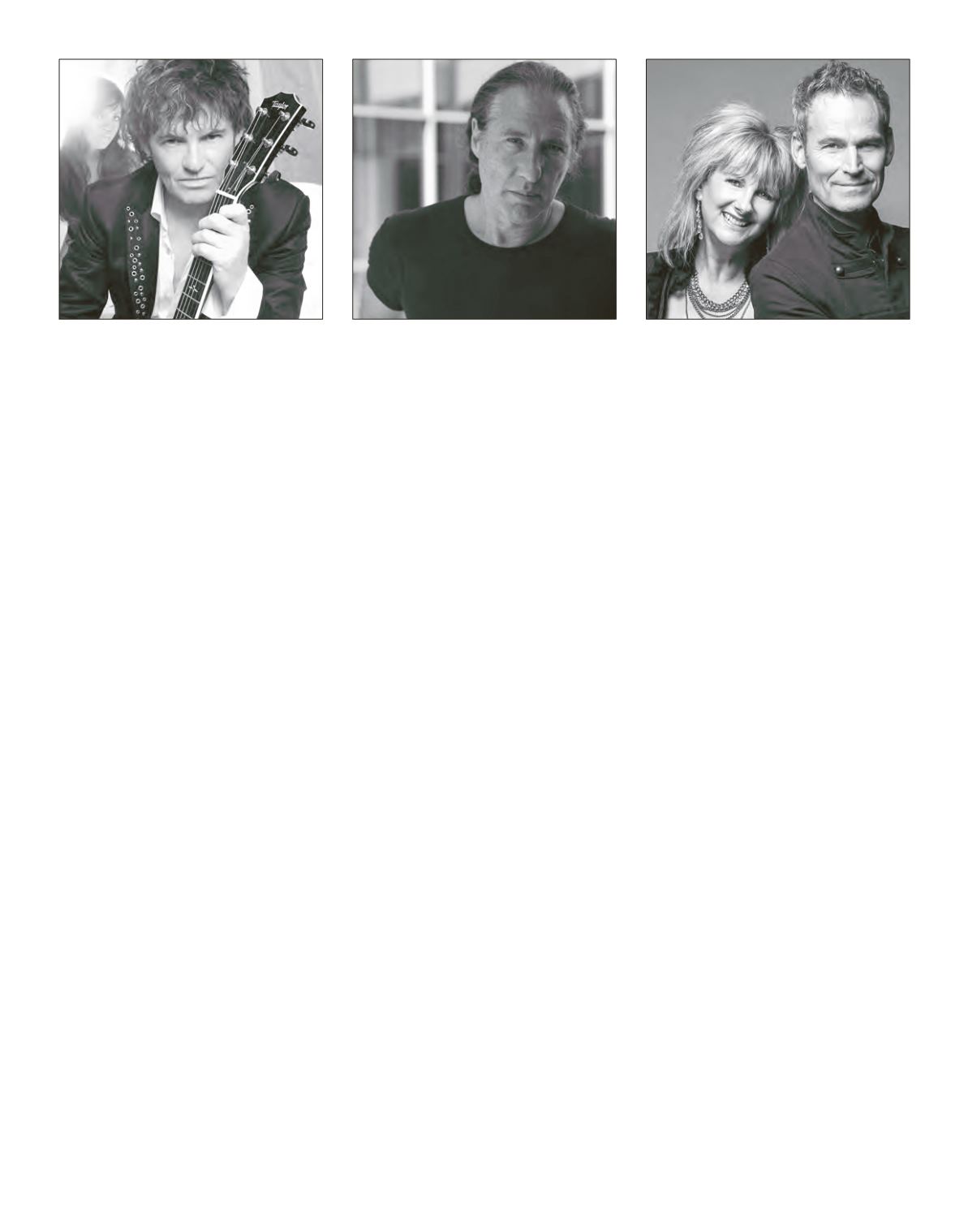

NAKED EYES
In his early days, while still performing in the
pubs of Bath, England, singer Pete Byrne and
keyboardist Rob Fisher formed the band Neon
with Curt Smith and Roland Orzabel. After re-
cording a few songs, the latter two split off to
form Tear for Fears, and Byrne and Fisher be-
came the synth-pop pioneers Naked Eyes. They
were soon signed by EMI and began working on
material in Abbey Road Studios, one day decid-
ing to try covering the Sandie Shaw standard “Al-
ways Something There to Remind Me.” The song
almost immediately hit the top 10, and with the
addition of their own tracks “Promises, Promis-
es” and “When the Lights Go Out,” Naked Eyes
was an almost constant presence on MTV and
the US airwaves in 1983. Rather than sending the
group on tour, the label put Naked Eyes back in
the studio, and
Fuel for the Fire
emerged the fol-
lowing year, featuring the hit single “(What) In
the Name of Love.” Rather than get pressed into
working up another new album in short order,
Byrne and Fisher split to pursue other projects.
Fisher teamed up with vocalist Simon Climie on
a couple of albums, one of which spawned the
hit single “Love Changes (Everything).” Mean-
while, Byrne collaborated with such artists as
Stevie Wonder, providing vocals on the num-
ber-one single “Part-Time Lover,” and Mary
Kate and Ashley Olsen, for whom he wrote and
produced a number of songs. The duo reunited
in the late ’90s to work on a third album, but
Fisher’s death in 1999 cut the project short. By-
rne featured several of the tracks on his 2001
solo album
The Real Illusion
, and in 2007 Naked
Eyes returned with the acoustic collection
Fum-
bling with the Covers
.
WANG CHUNG
Wang Chung’s story begins in the late 1970s,
when the creative core of Jack Hues and Nick
Feldman first met in London. Prompted by the
freedom of the punk music movement in En-
gland, they played together in several avant-gar-
de bands before finally becoming “Huang
Chung” in 1980. The band signed a recording
contract with Arista in 1981, after adding drum-
mer Darren Costin to the lineup, and released
its eponymous debut LP in 1982. The following
year, the group moved to the Geffen roster and
changed its name to “Wang Chung,” emerging
from the recording studio in 1984 with
Points
on the Curve
. “Dance Hall Days” off that disc
became Wang Chung’s first major UK hit, but
not its first in the US—the single “Don’t Let
Go” preceded it as a top-40 hit, and both tracks
topped the dance chart. By the summer of that
year, “Dance Hall Days” had become a glob-
al hit, but Costin left the group that fall. Hues
and Feldman took an experimental turn when
Oscar-winning director William Friedkin asked
them to score his 1985 film
To Live and Die in
LA
. The soundtrack album included not only
signature Wang Chung pop—the theme song
peaked just outside the top 40—but also several
instrumental tracks. Continuing as a duo, Wang
Chung released
Mosaic
in 1986, earning their
biggest success with the top-10 hit “Let’s Go!”
and the number-two smash “Everybody Have
Fun Tonight,” one of the most memorable songs
of the decade.
ANIMOTION
Before it could take off, the Los Angeles–based
retro science fiction band Red Zone broke apart
in 1983, despite receiving critical acclaim for its
sole album,
Living on Rust
(1982), and interest
from CBS records in a contract. The band’s sing-
er, Astrid Plane, along with producer Charles
Ottavio and label man Larry Ross, undeterred,
formed a new band: Animotion, a name invent-
ed to convey energy and motion. After recruit-
ing ex–Red Zone members Frenchy O’Brien
(drums) and Paul Antonelli (keyboards), Otta-
vio became the band’s bassist and Ross left CBS
to manage the group, also bringing in Bill Wad-
hams and co–lead vocalist. Animotion signed
with Polygram in early 1984 and released its
eponymous debut album later that year, with
Don Kirkpatrick (guitar) and Greg Smith (key-
board) rounding out the lineup. It wasn’t long
before LA’s KROQ radio began playing the single
“Obsession” in heavy rotation, and Animotion
found itself at the center of a five-day “battle of
the bands” in LA, ultimately besting such acts as
Frankie Goes to Hollywood. With “Obsession”
a top-10 hit and another top-40 single in “Let
Him Go,” Animotion began to hit the road, later
sharing the stage with Howard Jones on a stadi-
um tour around the world. The band solidified
its popularity in Europe with 1986’s
Strange Be-
havior
, featuring the singles “I Engineer” and “I
Want You.” The core lineup split from the band
by the late ’80s, but reunited in the early 2000s,
releasing
Raise Your Expectations
last year.
JULY 23 – JULY 29, 2018 | RAVINIA MAGAZINE
133









